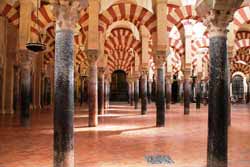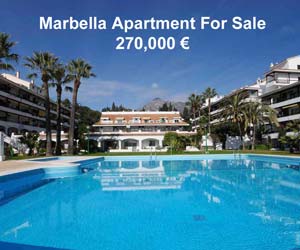Trip from Marbella to Córdoba
An Iberian and Roman city
Córdoba (called Cordova in English), is the capital of the province of Córdoba. An Iberian and Roman city in ancient times, in the Middle Ages it became the capital of an Islamic caliphate. It is thought that in the 10th and 11th centuries, Córdoba was the most populous city in the world and during these centuries became the intellectual centre of Europe. Today it is a moderately-sized modern city with a population of about a third of a million.
May is the best month to visit Cordoba, with its riot of colourful and fragrant celebrations. During May you can see the Battle of the Flowers parade, the Cruces de Mayo - a competition between city neighbourhoods of flower-decorated crosses, the Patios Festival where traditional Andalucía houses and their inner courtyards are bursting with potted flowers and plants. Finally, there's the Feria de Cordoba with horses, sherry and dancing.
Article continues below Ads ↓
The Mezquita
 The
Mezquita dates back to the 10th century. It is instantly recognisable by
alternate brick and stone horseshoe arches on top of stone pillars.
The approach is via the Patio de los Naranjos, a classic Islamic courtyard
with orange trees and fountains. Don’t miss the Mihrab with it's
shell-shaped ceiling carved from a single block of marble. Either side there are
chambers decorated with Byzantine mosaics
of gold. The Mosque-Cathedral of Cordoba is arguably the most significant
monument in the whole of the western Moslem World and one of the most amazing
buildings in the world in its own right.
The
Mezquita dates back to the 10th century. It is instantly recognisable by
alternate brick and stone horseshoe arches on top of stone pillars.
The approach is via the Patio de los Naranjos, a classic Islamic courtyard
with orange trees and fountains. Don’t miss the Mihrab with it's
shell-shaped ceiling carved from a single block of marble. Either side there are
chambers decorated with Byzantine mosaics
of gold. The Mosque-Cathedral of Cordoba is arguably the most significant
monument in the whole of the western Moslem World and one of the most amazing
buildings in the world in its own right.
The Alcazar
The Alcazar (of the Christian Kings) features a castle its delightful gardens
and a moorish bathhouse. This is a very popular monument. The attractive gardens
have descending terraces with rectangular Islamic pools. See the three towers – Lion Tower, Tower of Inquisition,
and the Homage Tower– all with their individual styles.
There are some Moorish style Royal baths in the basement that are fun to
visit. The first room is the changing room. The next three rooms are the
Cold Room, the Warm Room and the Hot Room. There are skylights in groups
of threes in the shape of stars which provide light and ventilation. The
walls are made from hardened clay and some of the original marble floor slabs
remain.
The Mosaic Hall includes the former chapel of the Inquisitions where there
are exhibits of magnificent Roman mosaic art from the 2nd and 3rd century
AD. Look out for a rectangular patio which is a fine example of Moorish architecture.
Juderia
 The maze of narrow and winding were where the Jewish merchants lived and
worked; you can visit the 14th century synagogue and a restored Sefardi
house. The atmospheric is less commercialised than in Seville although
souvenir shops have emerged.
The maze of narrow and winding were where the Jewish merchants lived and
worked; you can visit the 14th century synagogue and a restored Sefardi
house. The atmospheric is less commercialised than in Seville although
souvenir shops have emerged.
Torre de la Calahorra
Situated at the end of the Roman bridge, the tower's museum offers a fascinating insight into life in the Moorish city. There are great views from the tower. It currently houses the Institute for Dialogue between Cultures. This fascinating museum is particularly educational with audio visual presentations depicting life in Cordoba around the 10th Century AD when the three cultures of Christianity, Muslim and Judaism lived side by side.
Museo Romero de Torres
Julio Romero de Torres is much loved in his home town, and around Spain. His works, which you`ll see on posters everywhere, have adorned postage stamps and bank notes, and inspired songs and films.
Plaza del Potro
This long rectangular 15th century square slopes down towards the nearby
Guadalquivir river to the south. It gets its name from the 16th-century fountain
in the plaza. It is an octagonal structure having a small, prancing
horse balanced on a vase. the square used to have livestock markets
dealing mainly in horses..
The medieval Posada del Potro was a favourite of Cervantes who lived in Cordoba as
a child. The inn has two floors built around a narrow cobbled courtyard,
the upper floor with a gallery and wooden pillars and balconies - has now
been turned into a centre for the study of flamenco.
Palacio del Marques de Viana
This Palace, which was declared a National Monument and important Artistic
Garden, has a floor area of 6,500 m2, more than half of which is occupied
by the garden and the rest by a building with two floors and two little entresols.
Visitors are especially attracted by the elegant patios and the superb 18th
century garden of this palace which has lately become a museum, thanks to
the collaboration of an important institution in the town.
Jardin Botanico
Along the river from the Alcazar is a 10-hectare garden featuring hothouses, a rose garden, succulents and cacti, and a touch-and-feel garden. The hothouse has 130 plant species from the Canary Islands, divided into three areas by climate: moist such as geranium; desert plants, such as spiny and succulent (cacti and aloes); and a diverse group which includes ferns and Cycads (palms and ferns), as well as many native Spanish plants, also found in the Andalucian mountains and the Balearic islands. In the arboretum you will find the pinsapo, a fir tree native to Andalucia which can only be found in the Sierra de Grazalema and Sierra de la Nieves natural parks, while the conservatory has endangered woodland species. There is also a rose garden. There is also a café and shop.
Callejon de las Flores
Thismust be the most photographed street in Cordoba. The street is a narrow and cobbled with whitewashed houses which have balconies and walls full of flowers in terracotta pots. The alley is located close to the north-east corner of the Mezquita, off calle Victor Bosco,
Madinat al-Zahra (Azahara)
A restored Moorish city just outside Cordoba, with a fairytale air, and bursting with blooms such as oleanders, lilies and roses. Bronze griffins, lions and horses pour mountain water into thousands of marble fountains. Cypresses and palm trees shade huge reception halls and dream gardens form multi-coloured carpets of flowers..
Getting There:
From our apartment : Probably best to hire a car. Marbesol Car Hire is located just outside our complex. Or you could go by organised coach tour. The pick up is early in morning just outside our complex. During summer months, you may need to book in advance. Ask our apartment manager (Wendy) for details of how to book.
Have a nice Day
Another great trip from our apartment in Marbella

